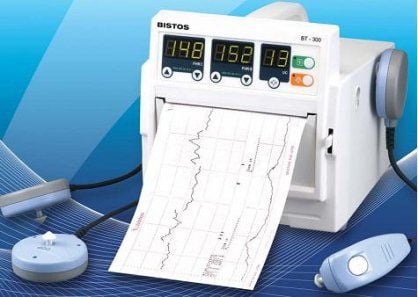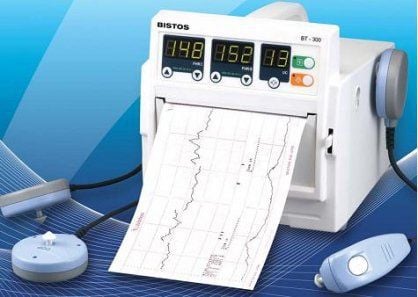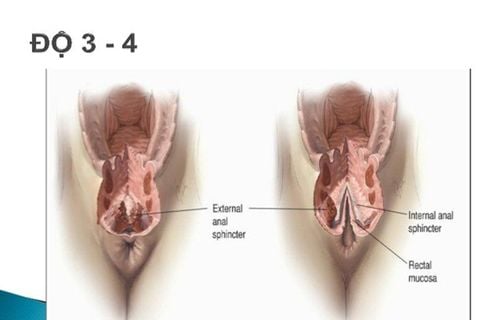This is an automatically translated article.
The article was written by Doctor Bui Thi Thu - Department of Obstetrics and Gynecology - Vinmec Hai Phong International General HospitalIn order to assess the baby's development in the womb, in addition to the measured indicators through ultrasound, obstetricians also rely on monitors to monitor fetal heart rate. This is a simple but extremely useful tool, helping doctors quickly give appropriate treatment. So what is fetal heart monitor, when and how, what does it mean? Let's find out in the article below.
1. What is a fetal heart monitor?
The regulation of fetal heart rate is the result of many interacting factors, including maternal factors (such as uterine contractions during labor) and factors from the fetus itself (such as gestational age, position, movement of the baby in the uterus).Using a probe placed on the wall of the mother's abdomen, the electrode records the frequency and amplitude of the fetal heart. The results are recorded continuously, drawing on paper a line that lasts throughout the installation process. This is called a fetal heart rate monitor.
In addition, monitoring fetal heart rate by monitor not only collects fetal heart rate information, but also records uterine contractions and fetal movements (mechanical movements) that occur during implantation. In principle, any time the fetal heart rate is recorded, the monitor can be monitored. However, in the third trimester (last trimester of pregnancy), especially in the days leading up to the due date or monitoring the heart instead of during labor, the role of the monitor is even more significant.
2. How is fetal heart rate monitor performed?
After being clearly explained how and what it means to monitor the fetal heart with a monitor, the mother will be taken to a quiet, secluded room and appropriately dressed.Pregnant women are asked to rest in a semi-sitting position, maybe slightly left side. The midwife will take your blood pressure and start attaching the device. The monitor's probe is placed in the position that feels the fetal heartbeat most clearly on the abdominal wall, held in place by elastic bands around the abdomen. At the same time, you will also be guided to use a mechanical pregnancy monitor by pressing a button when you feel your baby move. This signal will be recorded on paper at the same time as the fetal heart chart.

3. Results of fetal heart rate monitor
Monitor records the variation of values as follows:3.1. Basal fetal heart rate
Basal fetal heart rate is the average number of times your baby's heart beats per minute in the absence of contractions or fetal movement.Normal fetal heart rate is between 120 and 160 beats per minute. If it is over 160 times it will be called a fast beat and if it is less than 120 times it will be called a slow beat. Severe tachycardia or severe bradycardia is when the fetal heart rate is above 180 beats or less than 100 beats per minute.
3.2. Intrinsic fluctuations
When there is an external influence (such as contractions, fetal movement), the heart rate control center will stimulate the heart rate to increase, in order to supply more blood and to tolerate relative hypoxia. , especially during labor. Variations in fetal heart rate around the basal heart rate are called intrinsic fluctuations.Intrinsic oscillation is considered normal if the baby's heart rate rises more than 10 beats per minute above the basal fetal heart rate.
3.3. Fetal movements
Fetal movements are recorded by the mother's senses. During the follow-up period of 20 minutes, your baby is considered normal if there are more than 2 movements.In case the first 10 minutes has not seen the fetus, pregnant mothers are advised to "wake up" the baby by patting, shaking the belly or talking to the baby, letting the baby listen to music... Because only when there is fetal movement, the doctor can assess whether the internal fluctuations are normal or not.
4. Why is it necessary to monitor the fetal heart rate during labor with a monitor?
If the above parameters are within normal limits, the obstetrician will conclude that the baby's health is still good within a week. Therefore, in the last month, pregnant women should go to the doctor every week to assess the baby's condition.
The assessment of fetal health by monitor gives fairly reliable results, especially when monitoring in the late stages or high-risk pregnancies. Therefore, pregnant mothers will be completely assured when monitoring the fetal heart with a monitor for the baby, avoiding unfortunate risks.
Fetal heart monitoring by Monitor is fully implemented when the mother participates in the Maternity package at Vinmec International General Hospital.
With the desire to help mothers have the best preparation during pregnancy until "the mother is round and the baby is square, freeing up confusion with antenatal check-ups as well as necessary tests during pregnancy , Vinmec implements a package Maternity care program with the following service packages:
Maternity care program 2019 - 12 weeks Maternity care program 2019 - 27 weeks Maternity care program 2019 - 36 weeks Maternity Care Program 2019 – Labor When giving birth at Vinmec, mother and baby will be cared for by a team of doctors and nurses with professional and ethical experience, helping the pregnancy and labor process. become gentle, meaningful.
Please dial HOTLINE for more information or register for an appointment HERE. Download MyVinmec app to make appointments faster and to manage your bookings easily.














